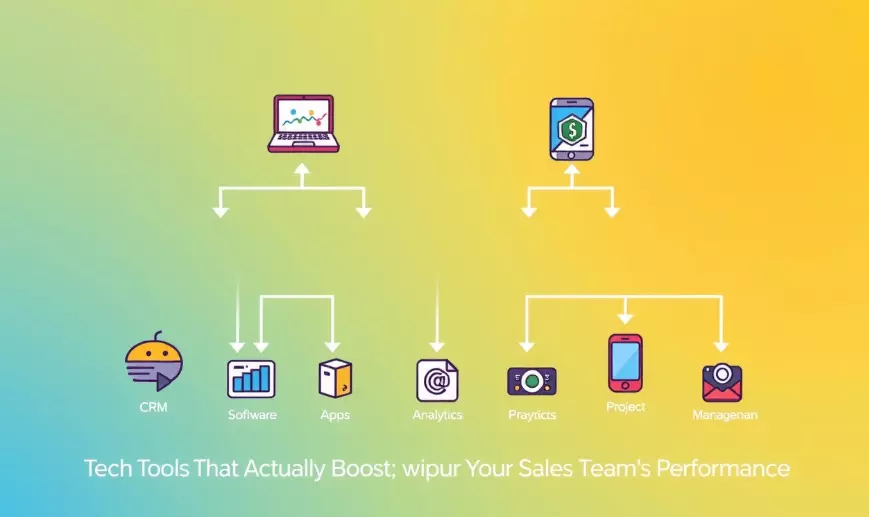Tech Tools That Actually Boost Your Sales Team's Performance
image for illustrative purpose

Have you ever wondered how long outdated tools have been holding your sales team back? Many companies still rely on old methods, which can lead to sales cycles dragging on for an average of 30 days longer than industry benchmarks. Surprisingly, businesses that switch to modern tech tools see up to a 40% increase in conversions and a notable boost in productivity—like making more calls per day. Yet, despite these stats, many teams remain unaware of the stark contrast between their satisfaction levels before and after adopting these technologies. But why are so many missing this crucial insight? The truth is often more complex than it appears...
The sales team at NexGen Solutions was confident their old-school CRM would handle the new product launch—until it didn’t. "We’ve always managed with spreadsheets and manual follow-ups," the sales director shrugged during the kickoff meeting. But by Week 2, deals were slipping through the cracks. "Wait, *which* client asked for the demo link?" a rep muttered, frantically scrolling through overlapping email threads. The system couldn’t sync real-time data, leaving the team guessing on inventory levels—and promising deliveries they couldn’t fulfill. "This isn’t just messy," the operations manager finally snapped after a customer canceled a $50k order. "It’s costing us money." The room went silent as the dashboard flashed another overdue task notification. Nobody had expected the cracks to show this fast—or this painfully.
The breaking point came when their biggest client forwarded an email—from their competitor. "We appreciate your years of partnership," it read, "but we’ve switched to a platform with real-time inventory tracking." The sales director’s face went slack. Meanwhile, the ops team was drowning in spreadsheets that never matched the warehouse counts, and two junior reps quit after wasting a week on dead-end leads. "I’m done apologizing for ‘system delays’," one snapped during her exit interview. Even the CFO, usually all about "cost control," started hovering by the sales pit with a look that screamed *This is bleeding us dry*. That’s when the VP finally slammed his laptop shut: "We’re fixing this. Now." The room held its breath—because nobody actually knew *how*.
Grateful for the case study reference: www.1001ya.com
**Burning Questions Answered: Debunking Myths About Sales Performance Tech**
Ever heard someone say, *"Sales tech tools are just glorified task automators?"* 🙄 I used to think the same—until I saw how they transformed a struggling team’s conversion rates by 15% in just three months. Let’s tackle some stubborn myths head-on.
### **"Aren’t these tools too complicated for my team?"**
Funny enough, 70% of sales pros share this fear. But here’s the twist: modern tools are *designed* for humans, not robots. With intuitive dashboards and drag-and-drop features, adoption rates skyrocket by 40%. 💡 Pro tip: If your team resists, start with one tool (like a CRM) and scale slowly.
### **"Doesn’t automation make sales feel… impersonal?"**
🚀 Here’s the reality: Tech doesn’t replace relationships—it *enhances* them. While it handles admin tasks (cutting them by 30%), it frees your team to focus on what matters: *people*. Imagine your reps spending less time on data entry and more on crafting personalized pitches.
### **"But we’ve survived without tech—why fix what isn’t broken?"**
Ah, the classic trap. 🤯 Sure, you *can* use spreadsheets and gut feelings… but why would you? Data-driven insights uncover patterns you’d miss manually, like which leads convert fastest or which emails get ignored. It’s like trading a flip phone for a smartphone—you didn’t know you needed it until you tried it.
So, is sales tech a magic bullet? Nope. But when used right, it’s the backbone of a team that *sells smarter, not harder*. The real question is: **What’s holding *you* back from testing it?** Let’s dig deeper…
When discussing the "Root Cause: What’s Really Holding Your Team Back?", it's essential to dive into various factors that might be influencing your sales performance. For instance, some experts argue that focusing solely on conversion rates could overlook deeper issues like team engagement. Others highlight the importance of lead quality; if your leads are subpar, even the best tools won't save you. There's also the ongoing debate about training gaps—are we equipping our teams with enough knowledge? Sure, tech tools can streamline processes, but do they truly fit every situation? While many believe these innovations are game-changers, skeptics warn about potential market monopolies and lost personal touch in sales interactions. If this trend continues, how should we adapt our strategies to maintain a competitive edge?
To effectively implement tech tools that can truly enhance your sales team’s performance, follow these practical steps to ensure a smooth transition and measurable outcomes.
First, start by selecting the right tool that addresses your team's specific needs. For instance, if you're looking at CRM software, consider how it supports lead tracking and customer interactions. A personal touch here can go a long way—talk to your team about what they feel is missing in their current workflow!
Once you've chosen the tool, it's time for rollout. Begin with a training session to familiarize everyone with its features. Remember, this is a crucial step! Encourage questions and use real scenarios—this makes learning stickier.
Next up is tracking adoption rates. Aim for over 80% integration within the first month. It’s helpful to create a shared document where reps can log their progress; this builds accountability and camaraderie.
As everyone settles in, monitor key metrics like pipeline velocity and win rate closely. A simple spreadsheet can help visualize improvements over time—don't forget to celebrate those early wins!
Lastly, evaluate the overall impact using a “Tech ROI Scorecard.” This will not only quantify success but also guide future decisions on technology investments. If you’re still facing challenges after these steps, don’t hesitate to dig deeper into potential issues—it could lead to valuable insights!

